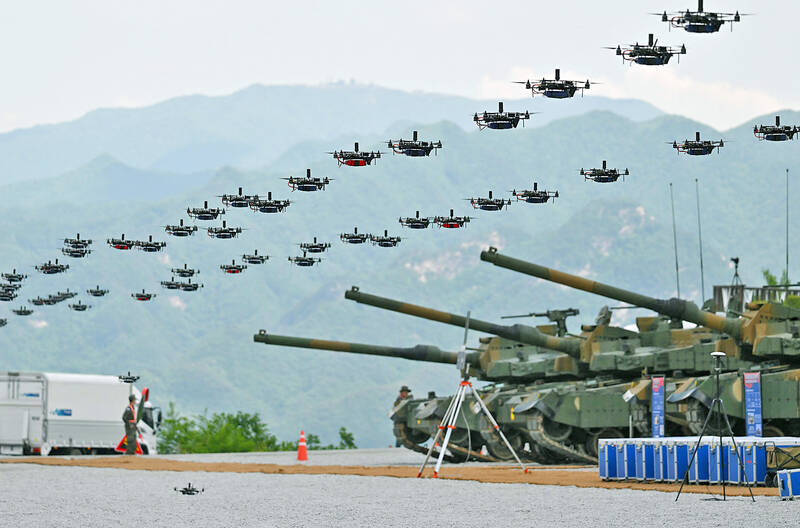The South Korean and US militaries were to begin massive live-fire drills near the border with North Korea yesterday, despite the North’s warning that it would not tolerate what it calls a hostile invasion rehearsal on its doorstep.
Yesterday’s drills, the first of the allies’ five rounds of firing exercises until the middle of next month, mark 70 years since the establishment of the military alliance between Seoul and Washington.
North Korea has typically reacted to such major South Korean-US exercises with missile and other weapons tests.

Photo: AFP
Since the start of last year, North Korea has test-launched more than 100 missiles, but none since it fired a solid-fuel intercontinental ballistic missile in the middle of last month.
North Korea has said its tests were in response to the expanded military drills between the US and South Korea, but observers have said the North aims to advance its weapons development to wrest concessions from its rivals in eventual diplomacy.
The US-South Korean firing exercises, called “combined annihilation firepower drills,” would be the biggest of their kind.
The drills have been held 11 times since they began in 1977, the South Korean Ministry of National Defense said.
This year’s drills are to involve advanced stealth fighter jets, attack helicopters, tanks and multiple rocket launch systems from South Korea and the US, the ministry said.
It was not immediately known how many troops would take part in the drills, but previous exercises in 2017 — the most recent ones before this year — drew about 2,000 soldiers and 250 weapons assets from both countries.
An earlier ministry statement said that the drills are meant to enhance the allies’ combined operational performance capabilities.
South Korea and the US would seek to establish “the overwhelming deterrence and response capabilities” to cope with North Korean nuclear and missile threats, it said.
On Friday last week, the North’s Korean Central News Agency (KCNA) called the drills “a typical North Korea-targeted war rehearsal.”
It said North Korea “cannot but take a more serious note of the fact that” the drills would be held in an area a few kilometers from its frontier.
The KCNA said the US and South Korea would face unspecified “corresponding responses” over their series of large-scale, provocative drills.
Earlier this year, the South Korean and US militaries conducted their biggest field exercises in five years.
The US sent the nuclear-powered USS Nimitz aircraft carrier and nuclear-capable bombers for joint exercises with South Korea.
North Korea could use the South Korea-US drills as a pretext to resume testing activities to attain its stated goal of modernizing its weapons arsenals, Seoul-based Korea Research Institute for National Strategy analyst Moon Seong-mook said.
Domestic issues such as North Korea’s push to increase agricultural production amid the rice-planting season could still affect its decision on weapons tests, he said.

The CIA has a message for Chinese government officials worried about their place in Chinese President Xi Jinping’s (習近平) government: Come work with us. The agency released two Mandarin-language videos on social media on Thursday inviting disgruntled officials to contact the CIA. The recruitment videos posted on YouTube and X racked up more than 5 million views combined in their first day. The outreach comes as CIA Director John Ratcliffe has vowed to boost the agency’s use of intelligence from human sources and its focus on China, which has recently targeted US officials with its own espionage operations. The videos are “aimed at

STEADFAST FRIEND: The bills encourage increased Taiwan-US engagement and address China’s distortion of UN Resolution 2758 to isolate Taiwan internationally The Presidential Office yesterday thanked the US House of Representatives for unanimously passing two Taiwan-related bills highlighting its solid support for Taiwan’s democracy and global participation, and for deepening bilateral relations. One of the bills, the Taiwan Assurance Implementation Act, requires the US Department of State to periodically review its guidelines for engagement with Taiwan, and report to the US Congress on the guidelines and plans to lift self-imposed limitations on US-Taiwan engagement. The other bill is the Taiwan International Solidarity Act, which clarifies that UN Resolution 2758 does not address the issue of the representation of Taiwan or its people in

US Indo-Pacific Commander Admiral Samuel Paparo on Friday expressed concern over the rate at which China is diversifying its military exercises, the Financial Times (FT) reported on Saturday. “The rates of change on the depth and breadth of their exercises is the one non-linear effect that I’ve seen in the last year that wakes me up at night or keeps me up at night,” Paparo was quoted by FT as saying while attending the annual Sedona Forum at the McCain Institute in Arizona. Paparo also expressed concern over the speed with which China was expanding its military. While the US

SHIFT: Taiwan’s better-than-expected first-quarter GDP and signs of weakness in the US have driven global capital back to emerging markets, the central bank head said The central bank yesterday blamed market speculation for the steep rise in the local currency, and urged exporters and financial institutions to stay calm and stop panic sell-offs to avoid hurting their own profitability. The nation’s top monetary policymaker said that it would step in, if necessary, to maintain order and stability in the foreign exchange market. The remarks came as the NT dollar yesterday closed up NT$0.919 to NT$30.145 against the US dollar in Taipei trading, after rising as high as NT$29.59 in intraday trading. The local currency has surged 5.85 percent against the greenback over the past two sessions, central